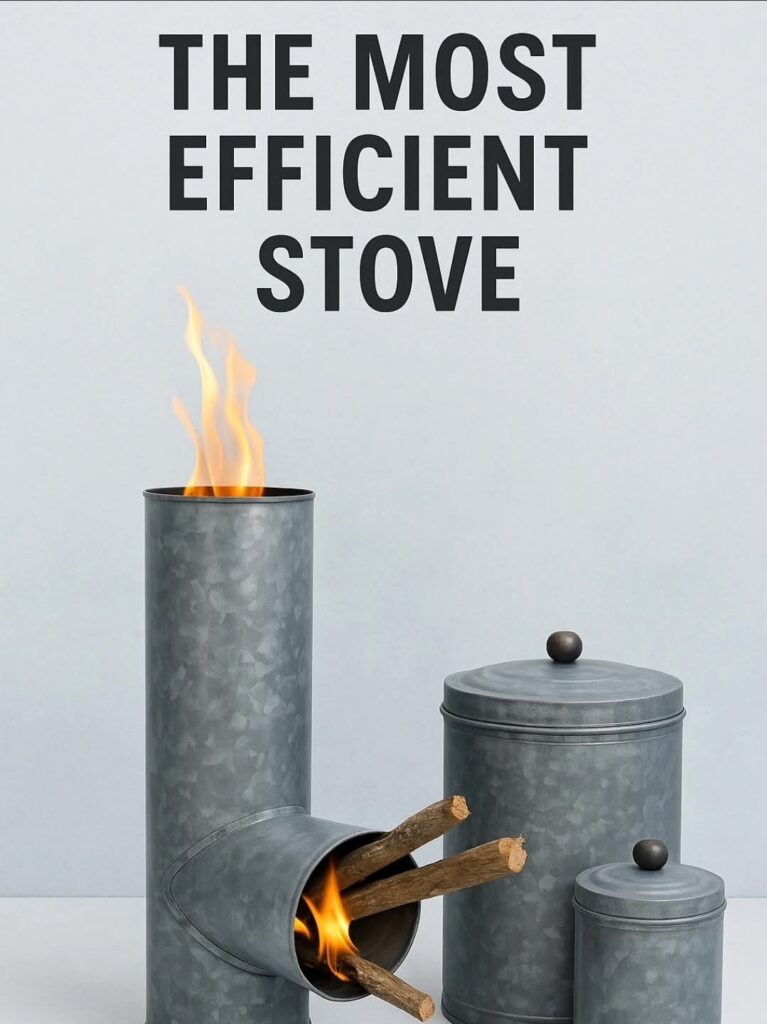🔥 Family Rocket Stove with Galvanized Cans
Efficient, economical and safe construction for sustainable cooking
🎯Why this version
Main Advantages:
- Real efficiency: well-insulated vertical riser, complete combustion, concentrated flame
- Low cost: uses galvanized cans as external casing and homemade refractory mix
- Modular: allows future expansions
🛡️Critical Safety Note
Galvanized is only external casing; it must not be in contact with flame or hot gases. The inside is lined with refractory (5–7 cm) and the cooking surface must be cast iron or stainless steel.
⚠️ Avoid heating galvanized surfaces (risk of zinc fumes).
🚫 Completely remove PVC used as mold: never leave PVC exposed to heat.
🛒Required Materials
📦Set of 3 Cans
- Large can 11″ (vertical): base chamber casing and riser foot
- Medium can 9″ (vertical, on top of large): extends the internal chimney
- Small can 7″ (horizontal, 90°): ashtray/air port
The galvanized prevents rust and serves as protective casing.
🔧Additional Components
- Wood inlet: 45° mouth entering the large can
- Cooking surface: cast iron or stainless steel plate
- Grate: stainless steel rods (6–8 mm)
🧱Refractory Mix
Optimized shopping list:
🔨Molds and Reinforcements
- PVC pipes 4″ → mold internal ducts
- Painters tape or duct tape → join PVC sections
- Stainless steel rods → grate to support wood
🛠️Step-by-Step Construction
1Prepare the Cans
- Remove lids from large and medium
- Keep bottom of large can (will be the floor)
- Remove bottom of medium can (hollow cylinder)
- Align medium on top of large and seal perimeter
– – – ⚠️Edges can be sharp: deburr or bend with pliers
2Work on the Large Can
- Wood inlet (45°): oval hole on lower side wall
- Ashtray/air (90°): circular hole on opposite side
3Place Molds (PVC 4″)
- Vertical PVC centered (total height = large + medium)
- 45° PVC until intercepting horizontal tunnel
- Ashtray/air PVC crossing both cans
- Join all sections with tape
4Mix and Pour Refractory
Mix ratios (use 1 qt container as measure):
| Component | Ratio | Function |
|---|---|---|
| Refractory cement | 1 part | Main binder |
| Silica sand | 2 parts | Structure and strength |
| Vermiculite/perlite | 1.5 parts | Thermal insulation |
| Grog | 1 part | Reduces shrinkage |
| Kaolin clay | ½ part | Plasticity and bonding |
| Wood ash | 10% of total | Natural flux |
Process:
- Mix all components dry
- Add water until «firm bread dough» texture
- Fill space between molds and walls (5–7 cm thick)
- Vibrate by gently tapping to release bubbles
- Embed grate in 45° mouth
5Curing and Demolding
- Cure: 24–48 h in the shade
- Demold: remove tape and take out PVC in sections
- Final cure: 7 days with plastic, lightly humidify
6Progressive Firing
Internal drying schedule:
👉 This process removes moisture without cracking the refractory.
🍲Use and Maintenance
Basic operation:
- 🔥Feed wood through 45° inlet, supported on the grate
- 🧹Clean ashtray every 2–3 uses
- 🍳Place metal grill on riser for pots
🔧Possible Modular Expansions
🍳Direct Plate
Cooking surface directly on the riser
🏠Oven
Heat chamber above riser for baking
🔥Space Heater
Channel heat to brick thermal bench
✅ Conclusion
If you build this version, share photos and boiling times (1 L of water) to improve the guide and help other families.
This piece is part of our Material Support routes and resilient cooking for daily life.
🚀 Start your Project 📸 Share Results📋Appendices
Appendix A — Mix Variants
If some component is missing:
- No kaolin: increase grog to 1.5 parts
- No vermiculite: use perlite (same ratio)
- No refractory cement: mix fat clay + sand (3:2), rammed; lower strength but repairable
Appendix B — Safety and Responsible Use
- 🌬️Always use outdoors or very ventilated area; carbon monoxide kills silently
- 👶Keep children away and have extinguisher/bucket of sand handy
- 🍳Do not cook on galvanized surfaces; use safe plate/grill
- 🌲Wood: dry, without paints or glues
🛒 Recommended Materials
Everything you need to build your rocket stove
📚 Sources
- Winiarski, Larry. Design Principles for Wood-Burning Cookstoves. Aprovecho Research Center, 2009.
- Still, Dean; MacCarty, Nordica. Capturing Heat II: The Improved Cookstove. Aprovecho Research Center, 2008.
- Evans, Ianto; Jackson, Leslie. Rocket Mass Heaters: Superefficient Woodstoves You Can Build (3rd ed.). Cob Cottage Company, 2014.
- World Health Organization. Guidelines for Indoor Air Quality: Household Fuel Combustion. WHO, 2014.
- Jetter, James J., et al. Pollutant Emissions and Fuel Efficiency of Biomass Cookstoves. Environmental Science & Technology 46(19), 2012.








Esta información esta genial, muy útil. Gracias! Saludos 🤗
Gracias por toda esta información tan buena. Exc página.👌
Gracias Mari por el feedback!